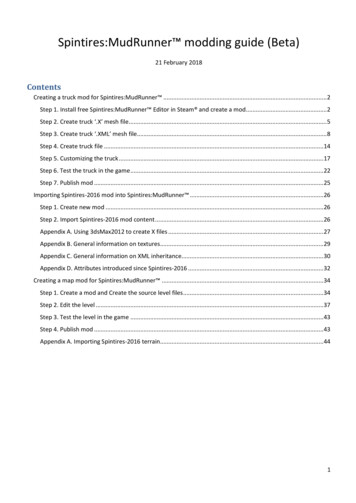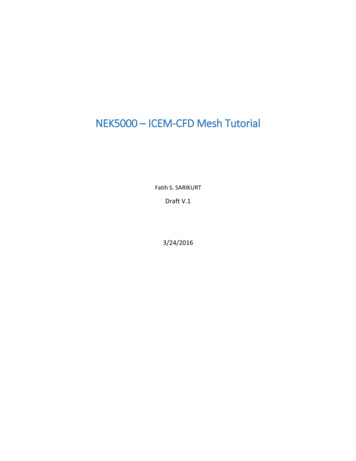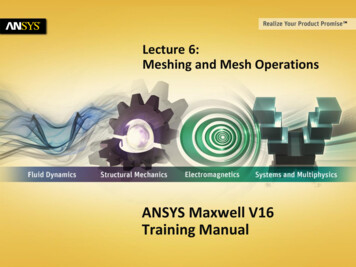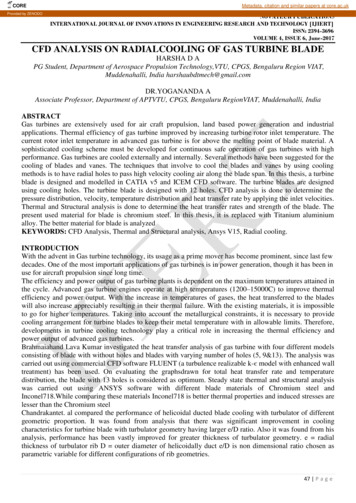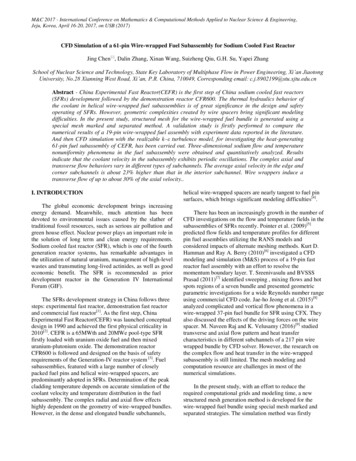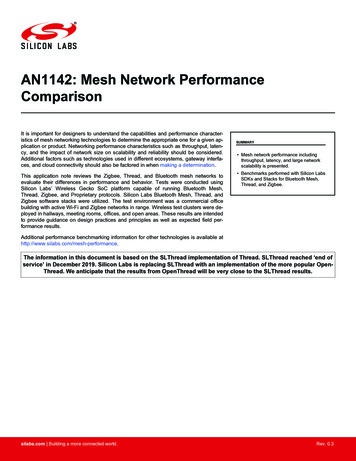
Transcription
AN1142: Mesh Network PerformanceComparisonIt is important for designers to understand the capabilities and performance characteristics of mesh networking technologies to determine the appropriate one for a given application or product. Networking performance characteristics such as throughput, latency, and the impact of network size on scalability and reliability should be considered.Additional factors such as technologies used in different ecosystems, gateway interfaces, and cloud connectivity should also be factored in when making a determination.This application note reviews the Zigbee, Thread, and Bluetooth mesh networks toevaluate their differences in performance and behavior. Tests were conducted usingSilicon Labs’ Wireless Gecko SoC platform capable of running Bluetooth Mesh,Thread, Zigbee, and Proprietary protocols. Silicon Labs Bluetooth Mesh, Thread, andZigbee software stacks were utilized. The test environment was a commercial officebuilding with active Wi-Fi and Zigbee networks in range. Wireless test clusters were deployed in hallways, meeting rooms, offices, and open areas. These results are intendedto provide guidance on design practices and principles as well as expected field performance results.SUMMARY Mesh network performance includingthroughput, latency, and large networkscalability is presented. Benchmarks performed with Silicon LabsSDKs and Stacks for Bluetooth Mesh,Thread, and Zigbee.Additional performance benchmarking information for other technologies is available athttp://www.silabs.com/mesh-performance.The information in this document is based on the SLThread implementation of Thread. SLThread reached ‘end ofservice’ in December 2019. Silicon Labs is replacing SLThread with an implementation of the more popular OpenThread. We anticipate that the results from OpenThread will be very close to the SLThread results.silabs.com Building a more connected world.Rev. 0.3
AN1142: Mesh Network Performance ComparisonIntroduction and Background1. Introduction and BackgroundSilicon Labs has provided performance testing results from embedded mesh networks as part of developer conferences and industrywhite papers. The basic performance data of throughput, latency, and impact of security can be used by system designers to defineexpected behavior. This testing has been previously presented for Zigbee and Thread networks as basic 15.4 mesh networking technologies. These were presented because performance varies even though both systems use the same underlying physical layer defined by IEEE 802.15.4. More recently, we have also published data on Bluetooth Mesh performance using the same test network inour Silicon Labs Research and Development (R&D) facility. The underlying performance details for each of these three mesh technologies are covered in the following individual application notes covering the testing conditions and results: AN1137: Bluetooth Network Performance AN1138: Zigbee Mesh Network Performance AN1141: Thread Mesh Network PerformanceThis paper is intended to present results from the three technologies so they can be evaluated against each other. No single technologyis expected to be used for connecting all devices, therefore, this paper provides performance comparisons so networks are used insituations best suited for the technology. Companies developing products can test the network’s performance for the expected usecase, and then use this data to assist in selecting the appropriate technology.This paper does not cover testing conditions and topology as this is covered in each of the individual performance papers. Each meshnetwork was tested under the same conditions and using the same wireless devices in our Silicon Labs R&D facility.silabs.com Building a more connected world.Rev. 0.3 2
AN1142: Mesh Network Performance ComparisonComparison of Results2. Comparison of Results2.1 Throughput and LatencyThroughput and latency is tested in a controlled network (wired configuration) to test each hop against different packet payloads.The normal configuration is to test to 6 hops. Testing is done with 1 source node and a series of routing nodes to allow the number ofhops to be varied.SourceNodeDestinationNodesFigure 2.1. Throughput and Latency Test Configurationsilabs.com Building a more connected world.Rev. 0.3 3
AN1142: Mesh Network Performance ComparisonComparison of Results2.1.1 Mesh Multi-Hop ThroughputThroughput testing uses the same single setup to evaluate the expected application level throughput of different payload sizes across adifferent number of hops.For smaller payload sizes, the throughput is lower as the network spends more time sending packet overhead versus application data.Figure 2.2. Small Packet Throughput 8-byte BT Seg and UnSeg and 10-byte ThreadFor larger payload sizes, the throughput is increased overall for Zigbee and Thread; however, the smaller payload size of BluetoothMesh does not result in the same increase in throughput. Note that all three technologies are fragmenting packets at this size.Figure 2.3. Throughput Comparison vs Hops 100-byte Payload Zigbee, Thread, and 96-byte Bluetoothsilabs.com Building a more connected world.Rev. 0.3 4
AN1142: Mesh Network Performance ComparisonComparison of ResultsIf we measure latency instead of throughput, we look at the small payloads first and see similar latency numbers between the differenttechnologies. Adding segmentation to Bluetooth increases the latency but everything stays below 200 milliseconds in round trip time.Figure 2.4. Small Payload - Latency vs HopsIf we look at a 4-hop chart versus a different payload size, we can see the increase in latency versus payload for the different technologies. All different mesh networks increase latency as the application payload increases. How well the network does under these conditions is related to the underlying fragmentation method as well as the congestion in the network when sending the data. Bluetooth mustsend many more packets as the payload size increases, so this segmentation adds more latency.Figure 2.5. Zigbee, Thread, and Bluetooth Latency - 4-hop versus Payload Sizesilabs.com Building a more connected world.Rev. 0.3 5
AN1142: Mesh Network Performance ComparisonComparison of Results2.2 Multicast Network Tests versus Network SizeThe throughput and latency results shown in Mesh Multi-Hop Throughput are somewhat constrained by the nature of the testing since itis a single string of devices. Open-air testing is required to validate stack performance under less controlled conditions. These networksare configured within Silicon Labs office space with normal Wi-Fi interference, other network operations, and building control systems.No attempt is made to isolate this network’s RF conditions.Because this testing is all multicast delivery, the Bluetooth flooding mesh is behaving the same as Zigbee and Thread because alldevice multicasts generally flood the network with three re-broadcasts from each router. These tests are all for relatively lightly loadednetworks where the multicast is sent every 3 seconds. In our individual testing, we noted that some network performances deterioratefurther as this multicast load is increased.The networks to be tested for each stack include: Small network: 24 devices Medium network: 1 – 48 devices Medium network: 2 – 96 devices Large network: 1 – 144 devices Large network: 2 – 192 devicesFor any of these tests, any number of devices within /- 10% of these network targets is acceptable. These networks are all configuredas powered devices. For each of these networks, the testing will validate reliability and latency for a set of traffic conditions. Testing isintended for over 100 packets.silabs.com Building a more connected world.Rev. 0.3 6
AN1142: Mesh Network Performance ComparisonComparison of Results2.2.1 Small Networks and Different Packet SizesFor each of these networks, we want to start testing with a small network and small payload sizes as the simplest comparison point. Asshown below, all three mesh networks provide very good performance with latency well under 200 milliseconds.Figure 2.6. Zigbee, Thread, and Bluetooth Multicast Latency 24 Node Network - 5 (or 8 Bluetooth) -byte PayloadAs the packet size increases, we start to see some differences in the multicast latency where it increases and spreads out. Threadlatency increases slightly, Zigbee increases and spreads out, and Bluetooth Mesh becomes very distributed in latencies from 20 millseconds up to 220 milliseconds.Figure 2.7. Zigbee, Thread, and Bluetooth Multicast Latency 24 Node Network - 50 (or 32 Bluetooth) -byte Payloadsilabs.com Building a more connected world.Rev. 0.3 7
AN1142: Mesh Network Performance ComparisonComparison of Results2.2.2 Large Networks and Different Packet SizesAs the network scales up, we expect an increase in latency due to added congestion and increased number of hops in the network.Since this is an open-air network, we do not control the number of hops a particular message takes, we only record the actual results.The chart below shows that for small packet sizes, all three networks behave reasonably with an increase and spreading of the latencyto slightly longer latencies. The only point of note is the 3% of Bluetooth packets that end up with latency larger than 250 milliseconds.Figure 2.8. Zigbee, Thread, and Bluetooth Multicast Latency 192 Node Network - 5 (or 8 Bluetooth) -byte PayloadAs the packet payload increases, we expect to see further increases in latencies across each of the mesh networks, particularly in thelarger networks where fragmentation of packets will result in even more congestion due to the multicast flooding. We increase the payload only slightly and see the latencies spread substantially. In the graph below, we have increased the X axis to better show the latency spreading in this larger network. All the networks spread out, but the Bluetooth network spreads well past 500 milliseconds. Furtherincreases in packet size only make this spreading worse.silabs.com Building a more connected world.Rev. 0.3 8
AN1142: Mesh Network Performance ComparisonComparison of ResultsFigure 2.9. Zigbee, Thread, and Bluetooth Multicast Latency 192 Node Network - 25 (or 16 Bluetooth) -byte Payloadsilabs.com Building a more connected world.Rev. 0.3 9
AN1142: Mesh Network Performance ComparisonSummary3. SummaryComparing different mesh technologies allows designers to review expected performance under different conditions. To allow as fair acomparison as possible, we ran these tests using the same wireless devices under generally the same open office conditions. We alsoattempted to minimize other factors impacting the testing such as the backchannel timing from the development kits, latency within thetesting infrastructure, and differences in radio architecture or MCU speeds, which can all impact results. Even when controlling thesefactors, we must caution that these results are our first attempt and further optimizations and improvements are likely possible withinthe standard or within our implementation. We have been running tests like these with our Zigbee stack since 2006, with Thread since2015, and on Bluetooth only within the past year.Each mesh network is designed differently and behaves differently. One network is not expected to be perfect for all conditions, so theselection of a particular technology involves criteria such as battery life, expected ecosystem and preferred connectivity, and the performance requirements of the device and network. This application note only compares the performance of these networks and notsome of these other critical parameters.From a performance standpoint, we see that all relatively small networks with small payload sizes perform similarly. As payload sizesand throughput needs increase, both Thread and Zigbee are better able to carry the load and maintain lower latencies. Latencies increase for all large networks, but Bluetooth experiences the largest increase. If we increase the payload in these larger networks, wesee even more substantial increases in latency. This increase is expected; therefore, larger networks should be moved to a routingsolution to minimize this latency. In all our multicast testing, however, we should note that our reliability is generally 99.9% or better asthe multicast does a good job of ensuring delivery of the messages.3.1 Related LiteratureThis application note has provided a comparison of the three mesh network technologies, Bluetooth, Zigbee, and Thread. For specificinformation on each of these technologies, refer to the following application notes: AN1137: Bluetooth Network Performance AN1138: Zigbee Mesh Network Performance AN1141: Thread Mesh Network Performancesilabs.com Building a more connected world.Rev. 0.3 10
port and litycommunity.silabs.comDisclaimerSilicon Labs intends to provide customers with the latest, accurate, and in-depth documentation of all peripherals and modules available for system and software implementers using orintending to use the Silicon Labs products. Characterization data, available modules and peripherals, memory sizes and memory addresses refer to each specific device, and "Typical"parameters provided can and do vary in different applications. Application examples described herein are for illustrative purposes only. Silicon Labs reserves the right to make changes withoutfurther notice to the product information, specifications, and descriptions herein, and does not give warranties as to the accuracy or completeness of the included information. Without priornotification, Silicon Labs may update product firmware during the manufacturing process for security or reliability reasons. Such changes will not alter the specifications or the performanceof the product. Silicon Labs shall have no liability for the consequences of use of the information supplied in this document. This document does not imply or expressly grant any license todesign or fabricate any integrated circuits. The products are not designed or authorized to be used within any FDA Class III devices, applications for which FDA premarket approval is requiredor Life Support Systems without the specific written consent of Silicon Labs. A "Life Support System" is any product or system intended to support or sustain life and/or health, which, if it fails,can be reasonably expected to result in significant personal injury or death. Silicon Labs products are not designed or authorized for military applications. Silicon Labs products shall under nocircumstances be used in weapons of mass destruction including (but not limited to) nuclear, biological or chemical weapons, or missiles capable of delivering such weapons. Silicon Labsdisclaims all express and implied warranties and shall not be responsible or liable for any injuries or damages related to use of a Silicon Labs product in such unauthorized applications.Trademark InformationSilicon Laboratories Inc. , Silicon Laboratories , Silicon Labs , SiLabs and the Silicon Labs logo , Bluegiga , Bluegiga Logo , ClockBuilder , CMEMS , DSPLL , EFM ,EFM32 , EFR, Ember , Energy Micro, Energy Micro logo and combinations thereof, "the world’s most energy friendly microcontrollers", Ember , EZLink , EZRadio , EZRadioPRO ,Gecko , Gecko OS, Gecko OS Studio, ISOmodem , Precision32 , ProSLIC , Simplicity Studio , SiPHY , Telegesis, the Telegesis Logo , USBXpress , Zentri, the Zentri logo and ZentriDMS, Z-Wave , and others are trademarks or registered trademarks of Silicon Labs. ARM, CORTEX, Cortex-M3 and THUMB are trademarks or registered trademarks of ARM Holdings.Keil is a registered trademark of ARM Limited. Wi-Fi is a registered trademark of the Wi-Fi Alliance. All other products or brand names mentioned herein are trademarks of their respectiveholders.Silicon Laboratories Inc.400 West Cesar ChavezAustin, TX 78701USAhttp://www.silabs.com
AN1142: Mesh Network Performance Comparison Comparison of Results silabs.com Building a more connected world. Rev. 0.3 7. 2.2.2 Large Networks and Different Packet Sizes As the network scales up, we expect an increase in latency due to added congestion and increased number of hops in the network. Since this is an open-air network, we do not .
